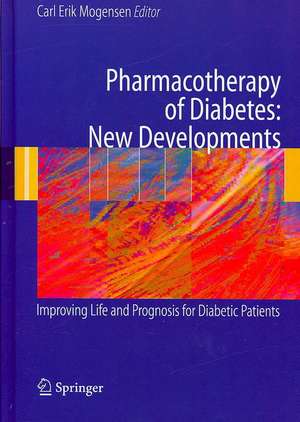Pharmacotherapy of Diabetes: New Developments: Improving Life and Prognosis for Diabetic Patients
Editat de Carl Erik Mogensenen Limba Engleză Hardback – 5 sep 2007
Treatment of Type 1 and Type diabetes has changed radically over the past few years. There are new opportunities for treating the key abnormality in diabetes, increased blood glucose, by effective agents such as new insulin preparations and oral agents.
Increasing so-called non-glycemic intervention is of prime importance. Blood pressure lowering therapies, anti-cholesterol strategies, and specific treatment related to complications is becoming increasingly important.
Pharmacotherapy of Diabetes is a unique, invaluable guide to all aspects of the pharmacological treatment of diabetes, covering basic concepts and an in-depth review of current and future therapies. This work provides an overview for the new changes in therapies that can be implemented in clinical practice and treatment of the diabetic patient.
| Toate formatele și edițiile | Preț | Express |
|---|---|---|
| Paperback (1) | 1098.99 lei 43-57 zile | |
| Springer Us – 4 noi 2010 | 1098.99 lei 43-57 zile | |
| Hardback (1) | 736.75 lei 43-57 zile | |
| Springer Us – 5 sep 2007 | 736.75 lei 43-57 zile |
Preț: 736.75 lei
Preț vechi: 775.53 lei
-5% Nou
Puncte Express: 1105
Preț estimativ în valută:
140.98€ • 147.56$ • 117.34£
140.98€ • 147.56$ • 117.34£
Carte tipărită la comandă
Livrare economică 31 martie-14 aprilie
Preluare comenzi: 021 569.72.76
Specificații
ISBN-13: 9780387697369
ISBN-10: 0387697365
Pagini: 289
Ilustrații: X, 289 p. 45 illus.
Dimensiuni: 178 x 254 x 24 mm
Greutate: 0.94 kg
Ediția:2007
Editura: Springer Us
Colecția Springer
Locul publicării:New York, NY, United States
ISBN-10: 0387697365
Pagini: 289
Ilustrații: X, 289 p. 45 illus.
Dimensiuni: 178 x 254 x 24 mm
Greutate: 0.94 kg
Ediția:2007
Editura: Springer Us
Colecția Springer
Locul publicării:New York, NY, United States
Public țintă
ResearchCuprins
Overview.- Pharmacoepidemiology of Diabetes.- New Definitions of Diabetes: Consequences.- Pharmacotherapy of Diabetes.- The Insulin Resistance Syndrome: Concept and Therapeutic Approaches.- Medical Emergencies – Diabetic Ketoacidosis and Hyperosmolar Hyperglycaemia.- Notes on the Use of Glucagon in Type 1 Diabetes.- Insulin and New Insulin Analogues, Insulin Pumps and Inhaled Insulin in Type 1 Diabetes.- Insulin and New Insulin Analogues with Focus on Type 2 Diabetes.- The Place of Insulin Secretagogues in the Treatment of Type 2 Diabetes in the Twenty-First Century.- Metformin – from Devil to Angel.- The Glitazones, Lessons so Far.- Antidiabetic Combination Therapy.- The Incretin Modulators – Incretin Mimetics (GLP-1 Receptor Agonists) and Incretin Enhancers (DPP-4 Inhibitors).- The Role of Alpha-Glucosidase Inhibitors (Acarbose).- Multifactorial Intervention in Type 2 Diabetes.- Treating the Comorbid Patient.- Obesity and Pharmacological Treatment.- Management of Diabetic Dyslipidaemia.- Coronary Intervention and Ischemic Cardioprotection in Diabetic Patients.- Diabetic Complications and Side-effects.- ACE-I and ARB and Blood Pressure Lowering, Including Effect on Renal Disease. Treatment of Advanced Diabetic Renal Disease.- Aspirin and Antiplatelet Drugs in the Prevention of Cardiovascular Complications of Diabetes.- Glycosylation Inhibitors, PKC Inhibitors and Related Interventions Against Complications.- Diabetic Foot Ulcers.- Pharmacotherapy in Diabetic Neuropathy.- Pregnancy – Pharmacological Problems.- Pharmacotherapy of Diabetic Retinopathy.- Pharmacotherapy in Diabetic Sexual Dysfunction.- A Bone Perspective.- Notes from Major Pharmaceutical Companies (all major companies asked to participate).- Achieving Guideline Control with New Pharmacotherapies:Albumin-Binding by Acylation of Insulin and GLP-1.- Pharmacotherapy of Diabetes.
Textul de pe ultima copertă
In the United States, 20.8 million children and adults, 7% of the population, have diabetes. While an estimated 14.6 million have been diagnosed, 6.2 million have yet to be diagnosed. Worldwide diabetes afflicts 150 million people. The World Health Organization estimates that by 2025 that figure will double. Diabetes is responsible for more deaths than AIDS and breast cancer, combined. It is a leading cause of blindness, kidney failure, amputations, heart complications and stroke.
Treatment of Type 1 and Type diabetes has changed radically over the past few years. There are new opportunities for treating the key abnormality in diabetes, increased blood glucose, by effective agents such as new insulin preparations and oral agents.
Increasing so-called non-glycemic intervention is of prime importance. Blood pressure lowering therapies, anti-cholesterol strategies, and specific treatment related to complications is becoming increasingly important.
Pharmacotherapy of Diabetes is a unique, invaluable guide to all aspects of the pharmacological treatment of diabetes, covering basic concepts and an in-depth review of current and future therapies. This work provides an overview for the new changes in therapies that can be implemented in clinical practice and treatment of the diabetic patient.
Treatment of Type 1 and Type diabetes has changed radically over the past few years. There are new opportunities for treating the key abnormality in diabetes, increased blood glucose, by effective agents such as new insulin preparations and oral agents.
Increasing so-called non-glycemic intervention is of prime importance. Blood pressure lowering therapies, anti-cholesterol strategies, and specific treatment related to complications is becoming increasingly important.
Pharmacotherapy of Diabetes is a unique, invaluable guide to all aspects of the pharmacological treatment of diabetes, covering basic concepts and an in-depth review of current and future therapies. This work provides an overview for the new changes in therapies that can be implemented in clinical practice and treatment of the diabetic patient.
Caracteristici
Provides a comprehensive and invaluable guide to all aspects of the pharmacological treatment of diabetes, covering basic concepts and in-depth review of current and future therapies Includes supplementary material: sn.pub/extras







